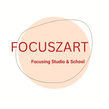EXPRESSIVE ARTS FOCUSING
Therapeutic studio art based on expressive arts practices used in Focusing settings, with or without fine art references
Trauma-informed Expressive Arts Focusing (EXAF) is one of the programs within the Museum-Art Based Receptive-Expressive Arts Focusing (MA-REAF) approach
Expressive Arts Focusing uses intermodal, Felt Sense-Based studio art to solve problems and heal emotional wounds from the present and past








